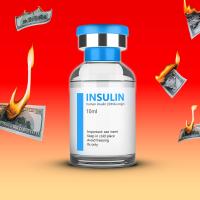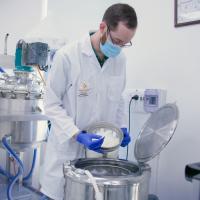A door-to-door vaccination campaign might be just what it takes to help the U.S.’s most vulnerable communities fight COVID-19.
Since COVID-19 vaccines first became available, data has generally shown that the communities least likely to be vaccinated are those that suffered health care disparities long before the pandemic began.
A group of dedicated volunteers is on a mission to solve for this imbalance by boosting vaccination rates with tailored, community-based strategies.
Some communities are more at-risk than others
The pandemic is a complex story with many unique regional threads.
Compared to urban communities, rural Americans are generally less likely to be vaccinated, more prone to being skeptical of vaccines, and have limited access to them.
In May 2021, the Centers for Disease Control and Prevention published a report showing that vaccine coverage was about 46% in urban counties and 40% in rural ones, adding that the 60 million people in rural America are at an increased risk of suffering or dying from severe forms of COVID-19.
One contributor to this disparity is vaccine hesitancy. A Kaiser Family Foundation poll from March found that 21% of rural Americans over the age of 18 said they would “definitely not” get a vaccine, compared to 10% of urban residents.
About half of rural respondents under age 65 said they’d never get a vaccine. Compared to their urban or suburban counterparts, rural Americans are more likely to view getting vaccinated as a personal choice “rather than part of everyone’s responsibility to protect the health of others,” the Kaiser poll found.
But even rural Americans who want to get vaccinated can face challenges.
There’s long been a lack of high-quality medical services in rural America, with more than 130 communities experiencing hospital closures over the past decade.
What’s more, health care in rural communities is often limited in terms of staff, specialization, and resources. That’s partly why rural Americans are more likely to die from conditions like heart disease and cancer than people who live near cities.
COVID-19 has only exacerbated these health gaps. In addition to having higher mortality rates, rural communities have had fewer vaccination sites. Some rural Americans have had access to mobile vaccination units, but those without access have to travel long distances to other vaccination sites. These trips can be difficult for the disportionately high percentage of rural Americans who are elderly and poor.
The accessibility gaps in rural America don’t only center around geography.
Millions of rural residents don’t speak English, making it more difficult for them to communicate with health professionals, and sign up for or learn about vaccines. And then there’s immigration status.
In February, the Department of Homeland Security said it’s “a moral and public health imperative” to vaccinate every U.S. resident regardless of immigration status. But some states have made it difficult for undocumented immigrants to get vaccinated. For example, Florida initially required people to show multiple proofs of residency in order to get vaccinated, before easing regulations in April.
Even in states without such mandates, it hasn’t always been clear who’s eligible for COVID-19 vaccines.
In March, for example, a Rite Aid in California denied the vaccine to two undocumented immigrants because they couldn’t produce a Social Security card, a step not required by law. The company later apologized.
Still, it’s not hard to imagine how such stories can increase vaccine hesitancy among undocumented immigrants, who might already be reluctant to get vaccinated because of concerns about side effects, a lack of health insurance, and missed work.
Boosting vaccinations among vulnerable populations often requires trust.
That’s exactly what The Center at Sierra Health Foundation has been building in its vaccination campaign for at-risk residents of California, through partnerships with trusted community organizations.
The door-to-door vaccination campaign to fight COVID
The Coalition Advocating for Pesticide Safety (CAPS) in California’s Tulare County might sound like an unlikely group to be teaching people about health during a pandemic. However, protecting people from the virus is pretty similar to protecting people from pesticides. After all, both require following safety practices, accessing resources, and educating people on health risks.
What really gives CAPS an advantage, though, is that they’ve been working with their local community for years, building trust through personal relationships. “Their work around COVID really builds off of the work that they’ve done in the past, to go into communities, to knock on doors, to meet people where they are,” Chet P. Hewitt, president and CEO of the Sierra Health Foundation and The Center, a partner of CAPS, told Freethink.
CAPS is an all-volunteer, nonprofit organization that’s aiming to boost vaccination rates in Central California by going door-to-door to talk to residents about vaccines and their concerns or challenges getting vaccinated.
This sort of grassroots, on-the-ground, vaccination campaign can be just as, if not more, effective than conventional public health messaging.
“When they show up and knock on the door, people are more likely to answer,” Hewitt said. “And when they convey messages, those messages are more trusted.”
In collaboration with healthcare professionals, these trusted community advocates could help the U.S. reach herd immunity, which most experts say would require vaccinating 70% of the population.
The CDC report from May noted that, despite lower vaccine uptake in rural communities, 86% of rural Americans said they would trust their healthcare providers for information on COVID-19 vaccines.
“Public health practitioners should collaborate with health care providers, pharmacies, employers, faith leaders, and other community partners to identify and address barriers to COVID-19 vaccination in rural areas,” the report stated.
In addition to helping the U.S. achieve herd immunity, boosting vaccination rates in at-risk communities would protect many of the essential workers who put themselves in danger during the worst parts of the pandemic.
“Some of the most marginalized communities across the state of California that helped the rest of us during the course of the pandemic were most exposed to the virus,” Hewitt said. “They stocked our shelves, they picked our food, they drove those busses, they showed up at hospitals.”
CAPS’ door-to-door vaccination campaign is certainly paying off – the Tulare committee president, Maria Reyes, says volunteers are able to convince most of the people they speak with to get vaccinated.


